Is Letting Cats Crunch Cardboard Fine :Ever caught your feline friend shredding a cardboard box? You might wonder if it’s safe. Cat behaviors can be puzzling, but knowing their play is key for pet safety.
Cats love cardboard for reasons we can’t fully explain. It’s not just random. They see cardboard as a source of fun and excitement.
This guide will explore cat-cardboard interactions. We’ll look at feline play, risks, and how to keep your pet safe and happy.
Cardboard crunching might look harmless, but there’s more to it. Let’s understand this behavior and keep your pet healthy and happy.
Table of Contents
Understanding Natural Cat Behaviors and Cardboard Attraction
Cats are amazing creatures with unique behaviors that often surprise us. Their love for cardboard is more than just play. It shows their natural instincts and need for enrichment.
Cats have a wide range of behaviors from their wild ancestors. Shredding cardboard is not just mischief. It’s a survival mechanism for them.
Why Cats Are Drawn to Cardboard Textures
Cardboard’s texture triggers many sensory responses in cats. Their sensitive paws and claws love to scratch and knead it. They also enjoy exploring its tactile sensations.
- Scratching and kneading the rough surface
- Exploring tactile sensations
- Experiencing a unique sensory playground
The Role of Territorial Marking
Cardboard is more than a toy for cats. Feline play with cardboard is a way to mark their territory. By scratching and rubbing, they leave scent markers for other animals.
Instinctive Hunting Behaviors
“Cardboard boxes are like miniature hunting grounds for domesticated cats.” – Feline Behavior Specialist
Cardboard boxes offer a space for cats to hunt like they did in the wild. They practice stalking, pouncing, and ambush. These skills are still with them, even though they’re domesticated.
The Benefits of Cardboard Play for Feline Mental Stimulation
Cat toys are key for your pet’s happiness and health. Cardboard scratching lets cats do natural things that are more than just fun. Adding cardboard to your routine gives your cat a rich experience.
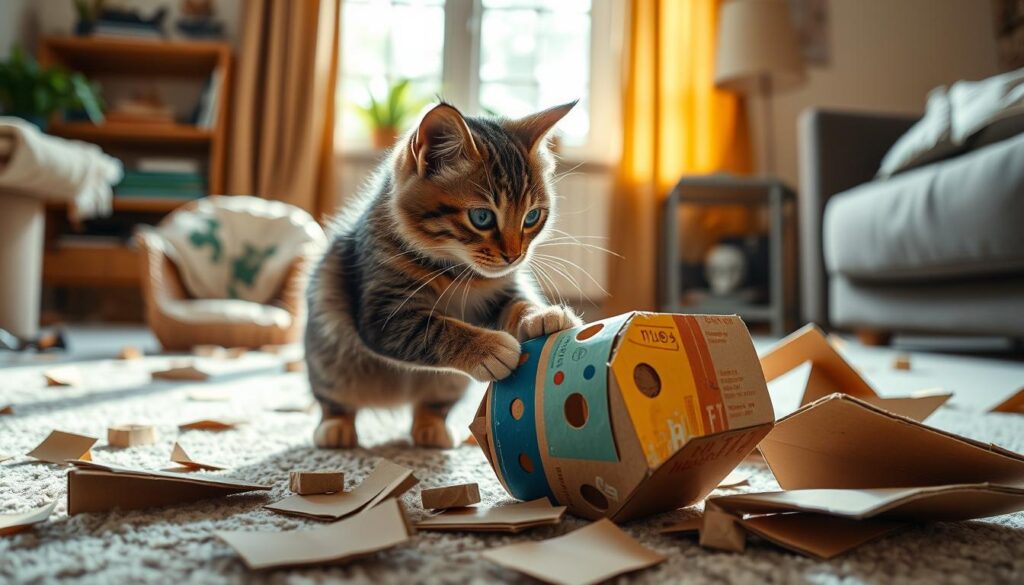
- Reduces stress and anxiety
- Prevents boredom in indoor environments
- Encourages problem-solving skills
- Supports natural hunting and exploration instincts
Indoor cats get a lot from cardboard toys. These simple objects can turn a dull day into a thrilling adventure. They offer chances for scratching, exploring, and playing, keeping your cat’s mind sharp.
“Cardboard isn’t just trash—it’s a playground for curious cats!” – Feline Behavior Specialists
Cardboard play also helps cats stay fit. It keeps them active, which is good for their weight and muscles. Scratching and shredding cardboard meets their instinctual needs.
Always watch your cat when they play with cardboard toys. This keeps them safe and makes their playtime even better.
Is Letting Cats Crunch Cardboard Fine: A Detailed Analysis
Cat owners often wonder if it’s safe for their pets to play with cardboard. Knowing the details about pet safety with cardboard can guide your choices for your cat’s playtime.
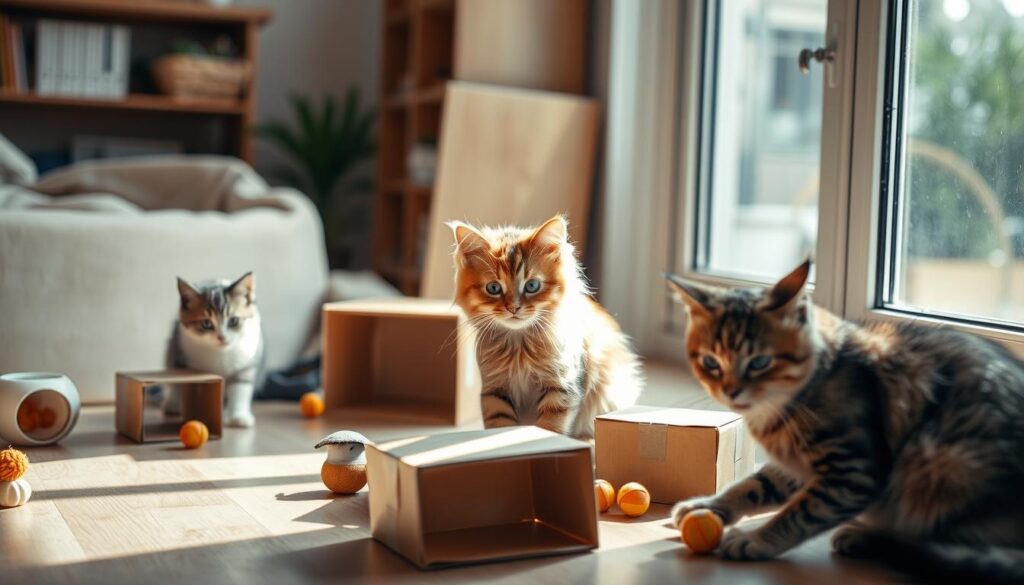
Letting cats play with cardboard can be safe and fun if done right. It’s important to think about the risks and your cat’s needs.
Physical Safety Considerations
There are key physical safety points to consider:
- Check cardboard for sharp edges or staples
- Remove any plastic tape or adhesive
- Make sure cardboard is clean and free from chemicals
- Watch your cat during play to avoid too much eating
Behavioral Impact Assessment
Cardboard play is great for your cat’s mind. They can:
- Feel less stressed through play
- Use their natural hunting skills
- Get mentally enriched
- Avoid boredom-related problems
Environmental Benefits
Cardboard play is not just about your cat’s safety. It also has environmental perks:
| Benefit | Description |
|---|---|
| Recycling | Use packaging materials again |
| Cost-Effective | Free fun for cats |
| Sustainable | Less need for bought toys |
“Understanding your cat’s play behaviors is crucial for creating a safe and stimulating environment.” – Feline Behavior Specialist
Even though cardboard is a great play material, always watch your cat. Take away any dangerous pieces to keep your pet safe.
Potential Risks of Cardboard Consumption
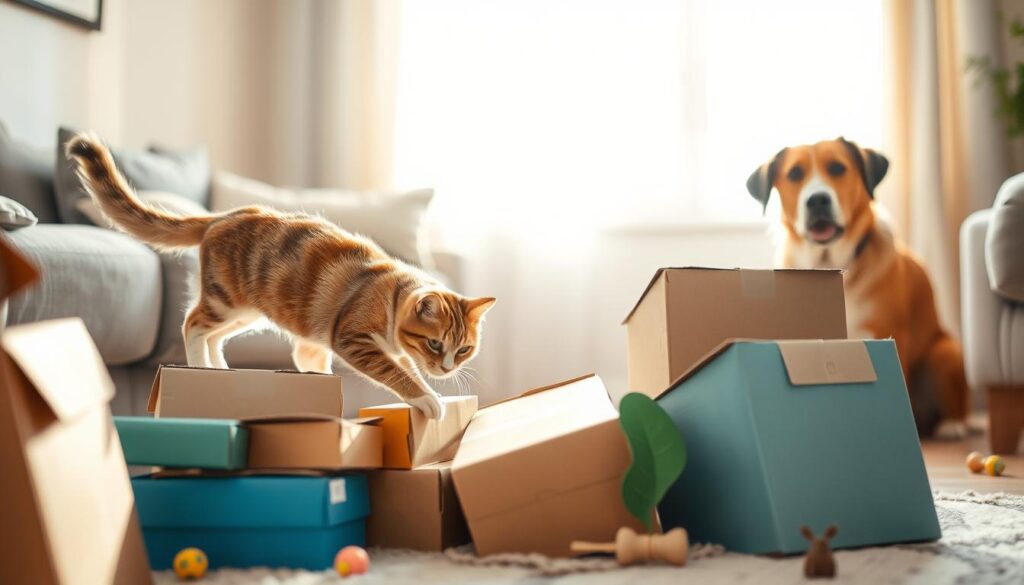
When we talk about pet safety, cat owners need to know the dangers of cardboard chewing. Cardboard might seem safe, but it can actually harm your cat’s health.
Vets say cardboard eating can cause serious problems:
- Potential digestive tract complications
- Risk of intestinal blockages
- Exposure to harmful chemical residues
- Potential choking hazards
Not all cardboard is created equal. Some types have harmful chemicals that can hurt your cat. Things like adhesives, printing inks, and chemical treatments can be toxic.
“Monitoring your cat’s cardboard play is crucial for preventing unexpected health complications.” – Veterinary Animal Behavior Specialists
Watch for these signs that your cat might be eating too much cardboard:
- Consistent aggressive chewing behaviors
- Swallowing large cardboard fragments
- Digestive distress after cardboard interaction
- Changes in eating or bathroom habits
If you see these signs, get help from a vet right away. They can figure out why your cat is chewing cardboard so much.
Safe Alternatives to Raw Cardboard Crunching
Cardboard can be fun for cat toys, but not all cardboard is safe. Your cat needs toys that are safe and fun. These toys should let them play naturally without harming them.
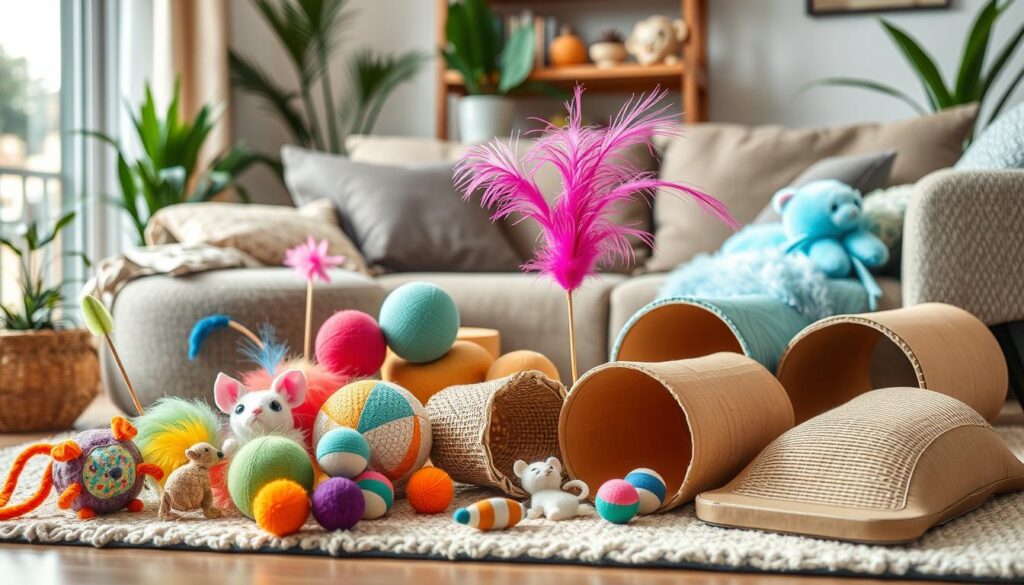
Looking for safer options than raw cardboard can keep your cat safe and entertained. These alternatives help keep your cat’s mind and body active.
Commercial Cardboard Cat Products
Professional cat toy makers have come up with new ideas. They make toys that are like cardboard but safer:
- Scratching boards with cardboard parts
- Interactive toys with cardboard textures
- Puzzle feeders with cardboard pieces
- Green cat toys made from safe materials
DIY Cardboard Toy Ideas
Making cat toys at home is fun and saves money. Here are some ideas:
- Cut cardboard into shapes
- Make tunnels and hiding spots
- Build puzzle feeders with cardboard
- Make sure edges are safe
“The key is providing safe, stimulating alternatives that channel your cat’s natural play behaviors.” – Feline Behavior Specialist
Always watch your cat when they play. Check homemade toys often for damage. Keep your cat safe and happy with fun toys.
Signs Your Cat’s Cardboard Interest Is Problematic

Having a pet can be fun but also comes with challenges. Cats often show interest in cardboard, which can turn from fun to a problem. It’s important to watch for signs of this.
Knowing when cardboard fascination turns into a problem involves looking for certain signs:
- Excessive cardboard shredding beyond normal play
- Aggressive protection of cardboard materials
- Neglecting food, water, or standard play activities
- Consuming cardboard fragments instead of just scratching
Warning indicators suggest your cat’s cardboard interest might escalate from harmless curiosity to potentially harmful obsession.
“When cardboard becomes more important than typical cat behaviors, it’s time to investigate,” says veterinary behaviorist Dr. Sarah Mitchell.
Your cat’s love for cardboard might mean they have deeper issues. These could include:
- Nutritional deficiencies
- Stress or anxiety
- Compulsive behavioral disorders
- Potential digestive complications
If your cat’s cardboard obsession doesn’t stop, it’s time to get help. A vet can check if it’s affecting your cat’s health or behavior.
Creating a Cat-Safe Cardboard Play Environment
Cat enrichment means giving your cat safe and fun play spaces. Cardboard play is great for keeping your cat’s mind and body active. It also supports their natural behaviors while keeping them safe.
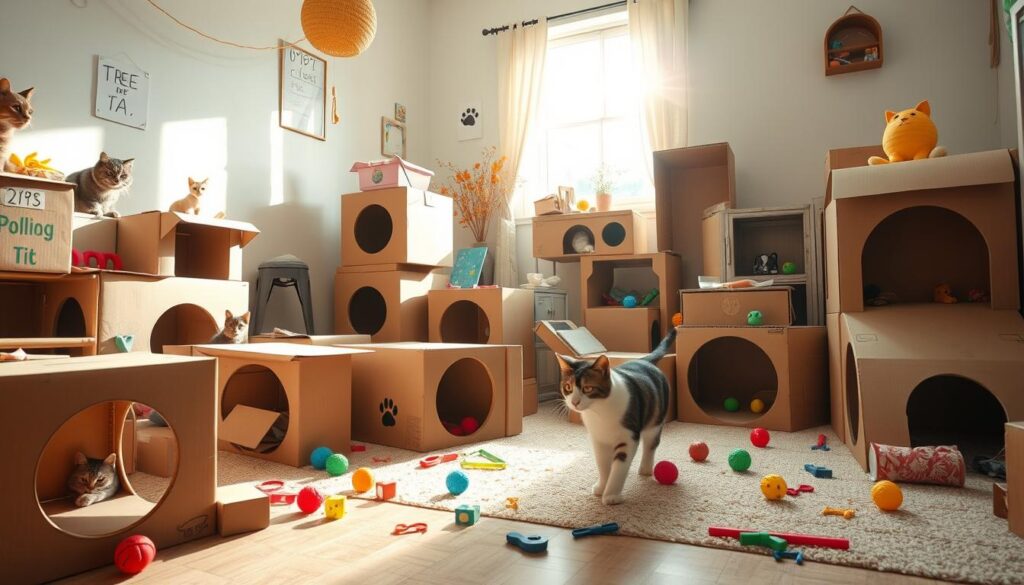
Setting up a cardboard play zone needs careful planning. Your cat’s play area should be safe and controlled. This helps avoid any risks.
Designing Designated Play Spaces
Here are some tips for creating a cardboard play area:
- Choose a specific corner or room for cardboard activities
- Ensure the space is free from electrical cords and fragile items
- Use a sturdy surface like a cat tree or scratching post as a play base
Supervision and Safety Guidelines
Watching your cat during cardboard play is key for safety. Follow these important tips:
- Inspect all cardboard items for potential hazards
- Remove staples, tape, and plastic attachments
- Limit play sessions to prevent overconsumption
- Watch for signs of excessive chewing or ingestion
| Safety Aspect | Recommendation |
|---|---|
| Material Check | Remove all non-cardboard attachments |
| Play Duration | 15-20 minutes per session |
| Replacement Frequency | Replace cardboard items weekly |
Pro tip: Rotate cardboard toys regularly to maintain your cat’s interest and prevent boredom.
“A safe play environment is the foundation of cat enrichment and happiness.” – Veterinary Behavior Specialists
When to Intervene in Cardboard Play

Having a pet can be fun but also comes with challenges. Managing your cat’s love for chewing cardboard is one of them. Knowing when to stop your cat’s cardboard play is key to keeping your pet and home safe.
It’s important to watch how your cat interacts with cardboard. Sometimes, what starts as fun play can turn into a health risk.
“Prevention is always better than cure in pet care.” – Veterinary Behavioral Experts
- Watch for signs of excessive cardboard consumption
- Monitor your cat’s chewing intensity
- Check for potential ingestion of cardboard pieces
- Assess your cat’s overall behavior during play
If you see certain signs, it’s time to step in. Aggressive behavior, distress, or compulsive cardboard destruction mean it’s time to change the game.
| Behavior Indicator | Recommended Action |
|---|---|
| Swallowing large cardboard fragments | Immediately remove cardboard and consult veterinarian |
| Showing signs of digestive discomfort | Stop cardboard play and monitor pet health |
| Destroying household items | Provide alternative interactive toys |
Getting advice from vets or animal behaviorists can be a big help. They can teach you how to keep your cat safe while keeping them happy and engaged.
Cardboard vs. Commercial Cat Toys: A Comparison
When looking into pet ownership, cat owners often debate the pros and cons of different toys. Cardboard and commercial cat toys each have their own benefits for keeping cats entertained and mentally stimulated.

Pet owners know that toys are key to keeping their pets active and engaged. Choosing between cardboard and commercial toys involves several important factors.
Cost-Effectiveness Analysis
Cardboard is a very affordable option compared to pricey commercial cat toys. Here’s a look at the cost:
- Cardboard: Free or very cheap
- Commercial cat toys: Usually cost between $5-$25
- Annual savings with cardboard: Could be $100-$300
Durability Considerations
The lifespan of cat toys differs a lot between cardboard and commercial ones:
| Toy Type | Average Lifespan | Replacement Frequency |
|---|---|---|
| Cardboard | 1-2 weeks | Frequent |
| Commercial Toys | 2-6 months | Occasional |
Pro tip: Mixing cardboard and commercial cat toys can offer the best mix of fun and value for your cat.
“Variety is the spice of life – even for cats!” – Veterinary Play Experts
While cardboard is a cost-effective choice, commercial toys have special features that can make playtime better. The goal is to find a balance that meets your cat’s needs and your budget.
Environmental Impact of Cardboard Cat Entertainment
Being a pet owner means taking care of the planet too. Cardboard cat toys are a green choice instead of plastic ones. They turn old cardboard into fun for your pet.
Cardboard is a smart way to keep your cat happy and the planet safe. It lets you use old packaging to make new toys. This way, you cut down on waste.
“One person’s recycling is another cat’s playground” – Eco-Friendly Pet Lovers
- Reduces plastic toy consumption
- Minimizes environmental waste
- Provides cost-effective entertainment
- Supports circular economy principles
When picking cardboard for your cat, think about these green tips:
- Choose clean, untreated cardboard
- Remove any staples or tape
- Recycle used cardboard toys responsibly
- Avoid cardboard with chemical treatments
Pro tip: Rotate cardboard toys to maintain your cat’s interest while preventing excessive material consumption.
Your green choices for pets really help the environment. Using cardboard for toys is a big step towards saving the planet. Plus, it keeps your cat entertained and happy.
Training Your Cat for Safe Cardboard Interaction
Understanding cat behaviors is key when introducing cardboard play. Cats explore by scratching, chewing, and checking textures. Your goal is to make cardboard play safe and fun.
Begin by setting clear rules for cardboard play. Use these strategies:
- Introduce designated cardboard play zones
- Redirect inappropriate chewing behaviors
- Use positive reinforcement techniques
- Provide alternative scratching surfaces
Give your cat treats and praise for good cardboard behavior. Consistency is key in shaping their behavior. Make cardboard play fun and safe, without bad habits.
“Training your cat requires patience and understanding of their unique personality and behaviors.” – Feline Behavior Expert
Try a structured training plan with this guide:
| Training Stage | Technique | Goal |
|---|---|---|
| Introduction | Supervised cardboard exploration | Understand safe interaction |
| Reinforcement | Treat-based rewards | Encourage positive behavior |
| Redirection | Alternative scratching options | Prevent destructive chewing |
Every cat is different. Be patient and keep training up. This way, you’ll create a safe, fun cardboard play area that meets your cat’s needs.
Expert Veterinarian Perspectives on Cardboard Play
Veterinary experts share important insights on cat behaviors and pet safety with cardboard play. They help us understand how to make a safe and fun space for our cats.
Cats have special ways of playing with cardboard. Veterinarians see these actions as natural and important for their minds. But, they also need to watch out for any concerns.
Medical Considerations for Cardboard Interaction
Vets say it’s important to watch your cat closely during cardboard play. They look out for:
- Signs of too much cardboard eating
- Allergic reactions
- Teeth and gum health
- How their body reacts to cardboard
“Cardboard play can be a healthy outlet for cats when done responsibly,” says Dr. Emily Rodriguez, a leading feline behavior specialist.
Professional Recommendations for Safe Play
Vets give tips to make cardboard play safe and fun:
- Change cardboard toys often to keep things interesting
- Watch your cat during playtime
- Offer other fun activities
- Keep cardboard toys clean and fresh
Knowing your cat’s special ways can make cardboard play more than just fun. It can help their mind and body stay healthy.
Conclusion
Deciding if it’s okay for cats to chew on cardboard is important for their safety. Cats can find cardboard fun and enriching, but it can also be risky. By watching them closely and knowing their habits, you can make cardboard play safe and fun.
Always think about your cat’s safety when they play with cardboard. Keep an eye on them, look for signs of too much chewing, and take away the cardboard if needed. This way, you can let their curiosity shine while keeping them safe.
Every cat is different, and what’s good for one might not be for another. Talking to a vet can give you advice that fits your cat’s needs. With the right care, your cat can enjoy cardboard play without getting sick or hurt.
Being alert and ready to act on your cat’s behavior helps create a fun and safe play area. This way, you can meet their natural needs while keeping them healthy and happy.

